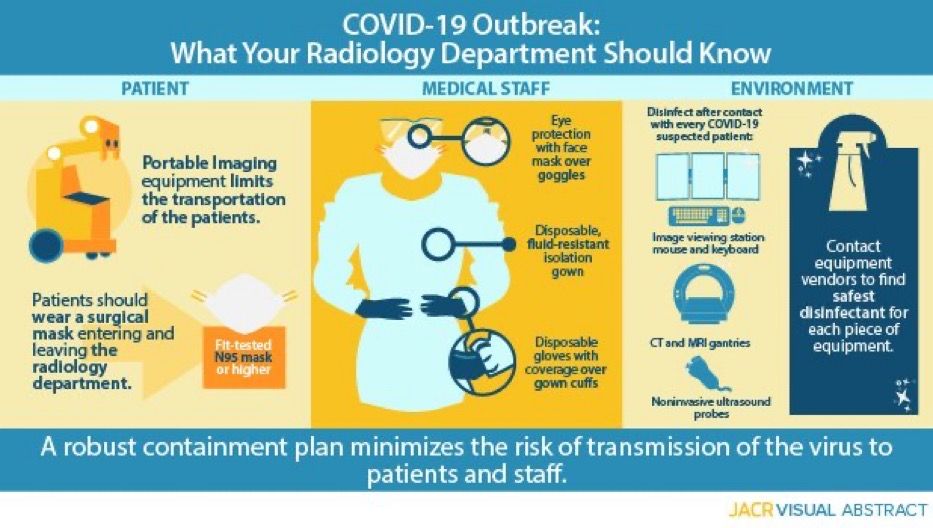COVID-19 Imminent in the U.S.: How Radiologists Can Reduce the Spread
Superior diagnosis with CT requires safety planning.

Courtesy: Journal of the American College of Radiology

The arrival and spread of novel coronavirus (COVID-19) in the United States is now considered, by the Centers for Disease Control and Prevention (CDC), to be nearly inevitable. As the medical providers at the front line of diagnosis, radiologists must be prepared to handle the looming influx of patients.
As of Feb. 26, COVID-19 has infected 81,386 individuals worldwide and has caused 2,771 deaths. Health officials anticipate that number will continue to rise, and part of combatting a wider spread is preparing for the amount of CT scans that will be ordered.
Because most patients present with respiratory distress, CT scans are recommended as the primary screening tool as it identifies potential virus cases faster than any other method. Recent data published in Radiology showed CT was more sensitive than gene sequencing for the virus by 27 percent – 98 percent to 71 percent, respectively. In fact, of the more than 1,000 study participants who were tested for suspected COVID-19 infection between Jan. 6 and Feb. 6, 2020, 59 percent had positive gene sequencing results, and 88 percent had positive CT scans. More importantly, 75 percent of patients with negative gene sequencing results actually tested positive with CT.
Consequently, it’s imperative for radiologists to be familiar with the possible symptoms associated with COVID-19 before the virus shows up on the nation’s doorstep. Pneumonia is the initial diagnosis, and imaging findings are largely bilateral with subpleural and peripheral distribution, ranging from ground-glass opacities in milder forms to consolidation in severe cases.
Preparing Your Practice to Limit Virus Transmission
It's also vital for radiologists to take protective steps. As COVID-19 has not yet made any significant appearance state-side, practices and hospitals have time to prepare. Guidance, recently published in the Journal of the American College of Radiology, lays out several tactics that can help limit the spread as you provide critical healthcare services.
The first step, according to a team led by the University of Southern California Keck School of Medicine, is to establish a protection protocol.
“A multi-disciplinary committee should convene to outline guidelines for imaging facility personnel to prevent virus spread through human-to-human contact and the department equipment,” they wrote. “Implementation of a robust plan can provide protection against further transmission of the virus to patients and staff members.”
COVID-19 is believed to transmit via respiratory droplets, but it’s currently unknown whether it can also be transmitted by touching a contaminated surface. Consequently, the team recommends facilities follow these protective measures:
- Use portable radiographic equipment to limit the transportation of patients whenever possible. Previous experience with the SARS virus shows dedicating equipment for use on infected patients can limit the risk of virus transmission.
- Patients who must be transported to the radiology department must wear a surgical mask. The CDC recommends a fit-tested N95 mask or higher, and a surgical mask can be used if an N95 mask isn’t available.
- Disinfect each CT and MR gantry, as well as noninvasive ultrasound probes, blood pressure cuffs, and image viewing station mice and keyboards after every contact with a patient suspected of COVID-19 infection. Wash them with warm water and soap or decontaminate them with a low-level or intermediate-level disinfectant, such as iodophor germicidal detergent solution, ethyl alcohol, or isopropyl alcohol. To ensure you’re using the safest disinfectant for each piece of equipment, contact the product manufacturer.
Practices who take the time, particularly before COVID-19 infections pop up in the United States, to implement these safety procedures, the team advised, will have a much better chance of limiting virus transmission and keeping employees safe.
GE HealthCare Debuts AI-Powered Cardiac CT Device at ACC Conference
April 1st 2025Featuring enhanced low-dose image quality with motion-free images, the Revolution Vibe CT system reportedly facilitates improved diagnostic clarity for patients with conditions ranging from in-stent restenosis to atrial fibrillation.
The Reading Room: Racial and Ethnic Minorities, Cancer Screenings, and COVID-19
November 3rd 2020In this podcast episode, Dr. Shalom Kalnicki, from Montefiore and Albert Einstein College of Medicine, discusses the disparities minority patients face with cancer screenings and what can be done to increase access during the pandemic.
Can Photon-Counting CT be an Alternative to MRI for Assessing Liver Fat Fraction?
March 21st 2025Photon-counting CT fat fraction evaluation offered a maximum sensitivity of 81 percent for detecting steatosis and had a 91 percent ICC agreement with MRI proton density fat fraction assessment, according to new prospective research.